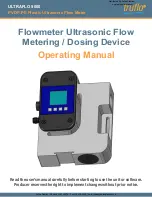
2
Chapter 1
Getting Started
Introduction
This User’s Guide describes the features, functions and operating procedures for the 881
and 882 Quantum Data video test instruments for testing analog and digital video display
devices. The 881 provides features for testing video displays in production environments.
The 882 is its complement. It provides extended features to test video displays for
development environments and quality assurance applications.
There are three versions of the 882: 1) the 882C (and CA which includes the analyzer)
and 2) the 882D and 3) 882E. The 882C provides two HDMI output ports (and two HDMI
input ports if the analyzer option is present), a composite video and S-video connector and
a VGA connector. The 882D provides a single HDMI output connector, a dual link DVI-I
connector and a composite video and S-video connector. The SDI/HD-SDI outputs are an
option for either the 882C or the 882D. The 882D does not support the analyzer option.
The 882E provides either HDMI outputs and inputs or a DisplayPort output and input.
Please note that you must us a PCMCIA card that is formatted in FAT16 filesystem. If you
use an card that is formatted in FAT32, the 882 will not boot.
882E features
The following are the standard and optional features of the 882E
•
Image Control Tool to fine tune deep color images (882E only).
•
DTV ready–Pre-programmed standard DTV formats are ready for immediate use.
Digital outputs support YCbCr color encoding. Analog outputs support tri-level
composite sync and YPbPr.
•
Built-in formats–Over 350 popular video formats are built-in including VESA, ATSC,
EIA-770.x, SMPTE 170, 240, 259, 267, 274, 292, 293, 295, 296, Australian,
EIA/CEA-861D, NTSC and PAL.
•
Central administration–Update and configure all networked instruments from a single
computer.
•
Network control–Fully control instrument from any network location with web browser
or Telnet client.
•
Graphics SDK–Create complex patterns based on your specifications using C++
software development kit.
•
HDMI–Full single-link HDMI 1.3. DVI HDCP production keys for HDMI output.
•
Easy to use–Access powerful features easily using intuitive user interface.
•
Multiple configurations–Save and restore different instrument configurations for
different applications.
•
Local pattern storage–Store multiple custom images (.bmp, .jpg, and .png) images in
instrument.
Summary of Contents for 881
Page 1: ...881 882 Video Test Instrument User Guide 882E for HDMI ...
Page 12: ...10 Contents ...
Page 50: ...38 Chapter 1 Getting Started ...
Page 84: ...72 Chapter 2 Testing Video Displays ...
Page 99: ...882 Video Test Instrument User Guide Rev A 35 87 ...
Page 102: ...90 Chapter 3 Administrative Tasks ...
Page 107: ...882 Video Test Instrument User Guide Rev A 35 95 ...
Page 216: ...204 Chapter 5 Working with Formats ...
Page 248: ...236 Chapter 7 Working with Images ...
Page 264: ...252 Chapter 8 Working with Test Sequences ...
Page 382: ...40 Chapter 11 Testing EDID for HDMI 2 Expand the EDID Block in the navigation view ...
Page 446: ...104 Chapter 12 CEC Interactive Troubleshooting Environment ITE ...
Page 493: ...882 Video Test Instrument User Guide Rev A 35 151 ...
Page 591: ...882 Video Test Instrument User Guide Rev A 35 213 Commands by name ...
Page 687: ...882 Video Test Instrument User Guide Rev A 35 309 Example DVIC 23 FMTU ...
Page 1018: ...580 Appendix B Image Reference The EMITest5 image is shown below ...
Page 1094: ...656 Appendix B Image Reference ...
Page 1124: ...686 Appendix C Error Messages ...
Page 1140: ...702 Appendix D Format Reference ...















































